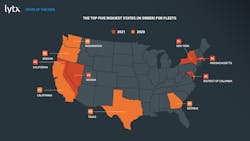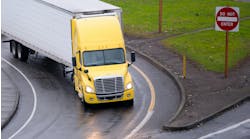Video telematics provider Lytx took more than 35 billion miles of customer driving data from 2021, combined it with many billions more miles of proprietary information from prior years, and generated its fourth-annual State of the Data report, which shows collisions and more severe accidents among its client fleets down substantially—25% and 17%, respectively—and identifies top five lists of dangerous driver behaviors and nationwide accident hot spots.
The report, released April 27, shows the coaching that client fleets provide their drivers—thanks to “events” captured from Lytx’s video platform—is working to help improve safety on the road and cut accidents, Gary Johnson, Lytx’s director of safety services, said in an interview with FleetOwner.
“When the technology—especially the video technology—came out, it was hard [for drivers] to embrace, but obviously more embrace it now, with proven results,” Johnson said. “You have technology like ours that notifies them immediately if there is a behavior that was detected. There is self-coaching. This is where we’re seeing clients embrace this.”
See also: Lytx offers self-correcting tool for truck drivers
The new findings show that drivers using the Lytx Driver Safety Program experienced fewer collisions, despite a post-pandemic increase in risky driving on U.S. roadways last year measured by the National Highway Traffic Safety Administration. These insights were derived from Lytx’s proprietary database of commercial vehicle driving data from 2019 through 2021, including more than 14 million risky fleet vehicle-driving events captured in 2021, according to a company release.
“In 2021, we boosted investments in our technology, innovations, partnerships, and people to acquire even more intelligence about transportation on our roadways,” added David Riordan, Lytx’s executive VP and general manager, enterprise. “We captured more than 35 billion miles of driving data last year, bringing our total dataset to over 185 billion miles. We analyze this data to help vehicle fleets better understand the risks on the road and the driver behaviors that can have a positive effect on safety.”
Data on driver actions derived in 2021 showed that their top five riskiest behaviors were:
- Not driving on a designated roadway.
- Driving too fast for conditions.
- Late response to a hazard or a change in road conditions.
- Failure to use mirrors.
- Running a red light.
Lytx’s DriveCam event recorders use machine vision and AI that can help address distracted driving in the moment and provide video evidence for a fleet’s protection when accidents do occur. The event recorders automatically detect 11 risky driving behaviors inside and outside the vehicle.
According to the April 27 release, the Lytx data also revealed increases in certain risky behaviors that fleet managers can address in their companies’ safety programs. Among them were the top five increased risk actions by drivers:
- Electronic device distraction while not on a cell phone. For example, viewing of movies on a computer or other electronics such as an iPad.
- Driver unbelted while driving off an identifiable roadway.
- Cell-phone distraction.
- Posted speed violation.
- Distractions other than electronic devices—consuming food or drink, for example.
According to Lytx, the data also measured the top five behaviors associated with events that almost resulted in collisions:
- Failure to keep adequate space around a vehicle.
- Distractions other than electronic devices—consuming food or drink, for example.
- Failure to use mirrors.
- Driver failure to scan an intersection adequately before entry.
- Late response to a hazard or a change in road conditions.
Top five behaviors associated with actual collisions:
- The driver took a risky action—took hands off the wheel for more than three seconds, for example.
- Failed to pay attention.
- Drove too fast for conditions.
- Failed to use mirrors.
- Distractions other than electronic devices—consuming food or drink, for example.
The report also reveals 2021’s riskiest states, cities, and roadways for driving in the U.S.—as well as the riskiest days and times to be on the road.
The states—New York, California, Nevada, Massachusetts, and the District of Columbia—were at least 1.5 times riskier than others due to their large populations, high traffic volumes, and unusual traffic patterns, according to Lytx.
More 2021 Lytx data revealed the riskiest cities and metropolitan areas. The New York area and Newark, New Jersey, topped this ranking. They were 28% riskier than the second city on the list, Chicago. Los Angeles, Long Beach, and Anaheim, California, were third followed by Atlanta at No. 4 and Philadelphia at No. 5.
These five road segments were 220 times riskier than the average roadway, according to the report. According to the Lytx, the riskiest roads in 2021 were:
- Interstate 94 near West G. Rogell Drive, which is close to the Detroit Metropolitan Wayne County Airport in Romulus, Michigan.
- U.S. 422, a narrow highway near Mercer Road in Butler, Pennsylvania.
- U.S. 422 near Glade Drive in Kittanning, Pennsylvania.
- Interstate 95 near the Port of New Haven in New Haven, Connecticut.
- U.S. 422 near East Butler Road in Butler, Pennsylvania.






